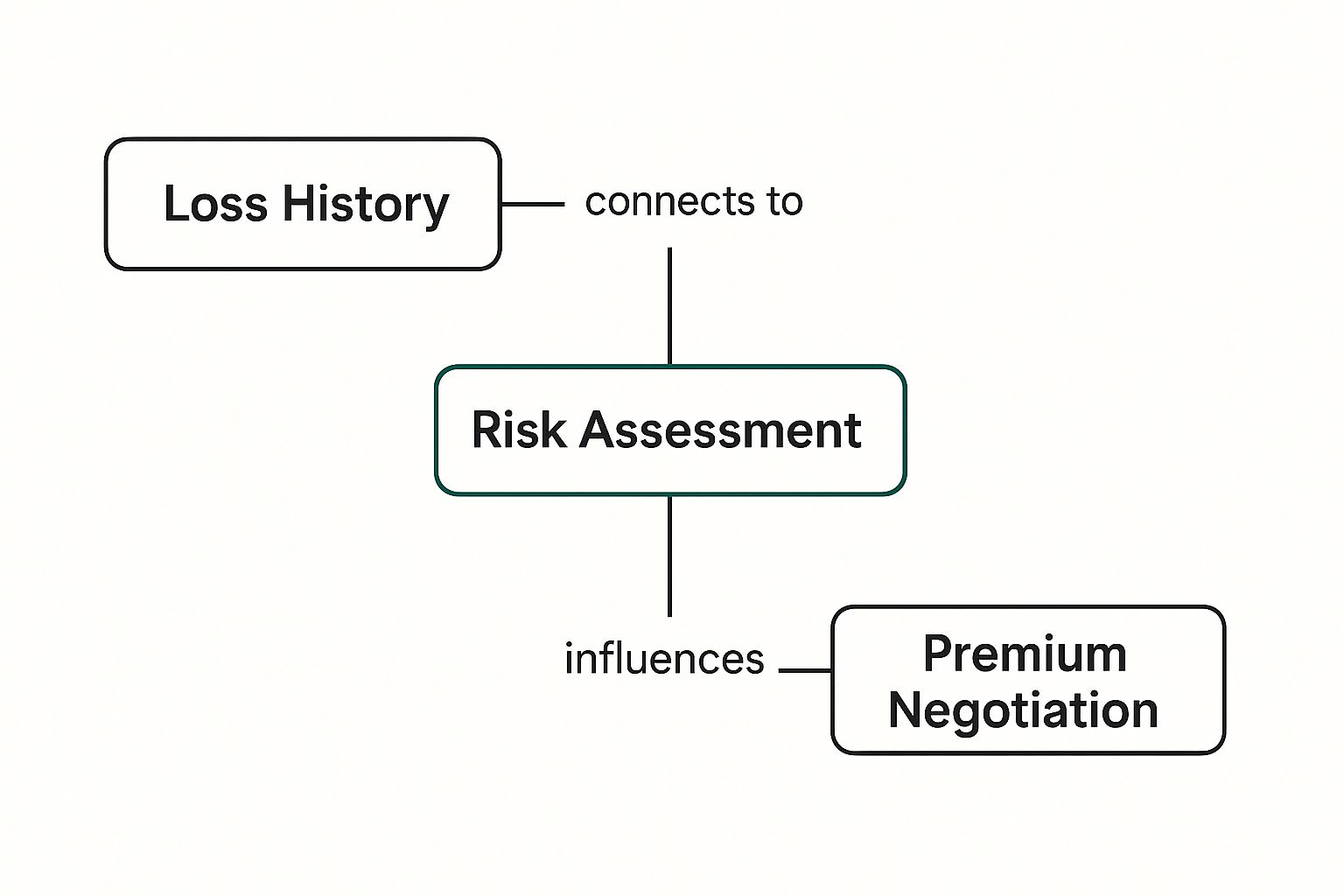Your Business Insurance Report Card Explained
If you've ever wondered how an insurance company decides your premium, the answer often lies in a single document: the loss run report. Think of it as your business's insurance report card. It tells the story of your company's claims history, giving underwriters a clear picture of your risk profile.
This report is arguably the most critical piece of information an underwriter examines when deciding whether to offer you coverage and, just as importantly, how much it will cost. A history with few or no claims suggests a well-managed, low-risk operation, which usually translates to better rates. On the other hand, a report showing frequent or costly claims signals a higher risk, and your premiums will likely reflect that.
Core Components of a Loss Run Report
So, what exactly is a loss run report? It’s a formal history of your insurance claims provided by your carrier, usually covering the last three to five years. Insurers began relying heavily on this kind of data in the 1990s, and it’s now a cornerstone of modern underwriting.
For business owners, especially those navigating the market for commercial insurance in New York, getting a handle on your claims history is step one. It's the primary tool an insurer uses to forecast potential future losses based on your past performance.
Key Takeaway: Your loss run report isn't just a list of past accidents. It’s a predictive tool that directly shapes your ability to get affordable, quality insurance coverage.
To really understand your report, you need to know the language. Getting familiar with the key terms will give you a major advantage when you review your own history or discuss your policy with your broker.
Below is a quick breakdown of the fundamental terms you'll find on any standard loss run report.
Quick Guide to Loss Run Report Key Terms
| Term | What It Means for Your Business |
|---|---|
| Date of Loss | This is the exact date an incident happened. It’s the starting point for tracking every claim's timeline. |
| Claim Status | Tells you if a claim is still "Open" (meaning it’s under investigation or in process) or "Closed" (it has been fully paid and resolved). |
| Paid Amount | This is the total dollar amount your insurer has actually paid out for a specific claim to date. |
| Reserves | This is the money the insurer has set aside to cover the estimated future costs of an open claim. It’s a crucial number to watch. |
Knowing these terms helps you speak the same language as your insurer and spot potential issues before they become major problems at renewal.
How to Read Your Loss Run Report Line by Line
At first glance, a loss run report can look like an intimidating wall of data. But once you know what you're looking for, it's not so complicated. Think of it less like a dense spreadsheet and more like a detailed history of your business's insurable incidents.
Learning to read this report is the key to understanding your risk profile. It tells a story, and knowing that story empowers you to take control of the narrative, especially when it's time to renew your policy.
Decoding the Core Data Points
Let's walk through the most important columns you’ll find on your report. Each one gives an underwriter a piece of the puzzle they use to evaluate your business.
- Date of Loss: This is straightforward—it’s the exact date the incident happened. Pay attention to how this date compares to when the claim was actually reported. Big delays could suggest a problem with your internal reporting process.
- Claim Status: This tells you if a claim is Open or Closed. An Open claim is still active, meaning the insurer is still investigating or making payments. A Closed claim is completely settled. Too many old claims that are still open can be a major red flag for insurers.
- Paid Indemnity: This is the actual, hard-dollar amount the insurance company has paid out on a claim to date. It’s money that has already left their bank account.
- Reserves: This figure is an educated guess by the adjuster. It’s the amount of money they’ve set aside to cover the expected future costs of an open claim. Because it's an estimate, it can sometimes be inflated.
This infographic shows how these data points fit together to influence your risk assessment and, ultimately, your premiums.
As the visual makes clear, a solid grasp of your loss history gives you a much stronger hand to play during premium negotiations. If you want to get really granular, knowing how to analyze data in Excel can help you spot trends and patterns that aren't obvious at first glance.
This kind of proactive analysis is a cornerstone of smart risk management. In fact, demonstrating a clean, well-managed loss history is one of the best ways to secure favorable terms on critical coverages like business continuity insurance.
Expert Tip: Keep a close eye on the Reserves column. If you see a large reserve amount tied to what you know was a minor incident, don't hesitate to question it. Contact your adjuster and ask for their reasoning. Overly cautious reserving can make your business look far riskier than it truly is, directly impacting your premiums.
Why This Report Is So Important to Insurers
To an underwriter, a loss run report isn't just a simple claims history. It’s their crystal ball for predicting your business's future risk. By digging into your past claims, they get a clearer picture of potential future losses, which is exactly how they decide on the premium you'll pay.
Their analysis goes deeper than just the total dollar amount paid out. Underwriters are trained to spot patterns, paying close attention to the frequency of your claims (how often they pop up) versus their severity (how much they cost). A string of small, frequent claims can be just as big a red flag as one catastrophic event, as it might point to deeper problems in your safety protocols or day-to-day operations.
The Underwriting Perspective
This report is the bedrock of their entire risk assessment. In fact, an estimated 85-90% of US insurers require loss run reports for commercial policies before they’ll even consider giving you a quote. That tells you everything you need to know about its importance.
A business showing several open claims with high reserves immediately signals a higher risk, and you can bet the underwriter will price the policy to reflect that. This kind of detailed look into your claims is a standard part of the process for any type of commercial insurance. Understanding it is as crucial as completing a thorough due diligence checklist during a major business deal.
Expert Insight: An underwriter isn't just looking at what happened; they're trying to figure out why. A single, massive claim from something unavoidable like a hurricane might be seen more favorably than a dozen smaller claims all stemming from preventable employee mistakes.
At the end of the day, how an underwriter reads your loss run report directly impacts your premium. A clean, accurate report is your best negotiating tool come renewal time. It’s your proof that the business is a well-managed risk worthy of a competitive rate.
Simple Steps to Request Your Loss Run Report
Getting your hands on your loss run report is a fundamental right you have as a policyholder. Don't think of it as a special favor—it's your data. The process is usually quite simple, much like requesting your personal credit report.
Your first stop should always be your current insurance broker or agent. In most cases, a quick phone call or a simple email is all it takes to get the ball rolling. They work with the carrier every day and can typically request and pull the report for you without any fuss.
What to Include in Your Request
To make sure things go smoothly and you get what you need without a lot of back-and-forth, it pays to be specific. Whether you're talking to your broker or reaching out to the carrier directly, make sure you have this information ready:
- Your full, official business name
- Your policy number(s) for every type of coverage
- The specific policy years you need (most underwriters will want to see three to five years of history)
- A clear but reasonable deadline for when you need the reports
Providing these details upfront helps the carrier locate your records quickly and generate the right documents the first time. For more tips on managing your coverage effectively, our guide to business insurance basics is a great place to start.
Know Your Rights: It's important to remember that in most states, insurance carriers are legally obligated to provide your loss run reports within a set timeframe. This is often around 10 to 15 business days. If you feel you're getting the runaround, sending a formal written request creates a paper trail and reinforces your right to the information.
Proactive Steps To Improve Your Claims History
Think of your loss run report as more than just a historical document; it's a strategic roadmap for making your business stronger and more attractive to insurers. By getting ahead of the game, you can shape your risk profile, which often leads to better premiums and more favorable coverage terms down the road. The whole process starts with a careful, hands-on review of the report itself.
From Report To Action Plan
Once your report is clean and accurate, it's time to put that data to work. Your claims history tells a story, pointing directly to your business's vulnerabilities. Use these insights to build a concrete action plan and strengthen your day-to-day operations.
For example, a solid, proactive strategy could include:
- Implementing Enhanced Safety Protocols: If your report reveals a pattern of similar accidents or injuries, it’s a major red flag. This is your chance to revisit and improve the specific safety procedures that are clearly not working as intended.
- Improving Employee Training Programs: Don't just train once. Regular, documented training sessions on safety and proper incident reporting keep best practices top-of-mind and show underwriters you're serious about risk.
- Fostering Immediate Incident Reporting: Build a workplace culture where employees feel empowered to report any incident right away, no matter how minor it seems. This is crucial for stopping small issues from ballooning into costly, complex claims.
Making these kinds of operational improvements is how you start building a cleaner loss run report for the future. You're showing insurers that you’re actively managing risk, not just waiting for things to go wrong.
A loss run report isn't a final grade—it's a diagnostic tool. Using it to identify and correct operational weaknesses is one of the most effective ways to lower your long-term insurance costs and protect your business.
For particularly complicated situations, it can be helpful to see how outside experts can help. Understanding the benefits of hiring a public adjuster can provide a path to better claim outcomes, which directly improves your overall history. Just correcting one old, lingering claim can make a surprisingly big difference when your next insurance renewal comes around.
Loss Run Report Review Checklist
To get started, treat your review like a detailed audit. Scrutinize every line, looking for inaccuracies that might be inflating your premiums. The most common culprits are incorrect claim details, duplicate entries, or claims that were settled ages ago but are still marked as "Open." An open claim, especially one with high reserves set aside, can make your business look far riskier than it actually is.
This checklist can help guide you through a thorough review.
| Check Point | Action to Take | Why It's Important |
|---|---|---|
| Claim Status | Identify any claims listed as "Open" that have actually been resolved. | Open claims, especially with high reserved funds, signal ongoing risk and can significantly increase your premiums. |
| Claim Details | Verify dates, descriptions, and parties involved for every listed claim. | Inaccurate details can misrepresent the nature and severity of an incident, leading to a skewed risk assessment. |
| Financial Data | Check the "Amount Paid" and "Amount Reserved" figures for accuracy. | Incorrect financial data can make your loss history appear worse than it is. Reserved funds that are too high are a common issue. |
| Duplicate Entries | Scan the report for any claims that appear more than once. | Clerical errors can lead to duplicated claims, artificially inflating your loss history and making you look like a higher risk. |
| Claim Patterns | Look for recurring types of claims (e.g., slips and falls in one area). | Identifying patterns is the first step toward creating targeted safety improvements and preventing future losses. |
By methodically working through these points, you can ensure your loss run report is a true and fair reflection of your company's risk, giving you the power to negotiate from a position of strength.
Got Questions About Loss Run Reports? We've Got Answers.
Even after you get the basics down, it's natural to have more specific questions about loss run reports. The little details are what truly matter when you're trying to manage your insurance and get the best possible rates. Let's dig into some of the most common questions we hear from business owners.
Getting these points cleared up gives you a full picture of what a loss run report is and, more importantly, how it works in the real world. This is the kind of knowledge that puts you in the driver's seat when it's time to talk about your policy.
How Far Back Does a Loss Run Report Go?
This is probably the most frequent question we get, and the answer directly affects your ability to shop around for new insurance.
Typically, a standard loss run report will show your claims history for the past three to five years. Underwriters need this much history to see the whole story. It helps them spot any patterns—good or bad—that might predict future risk.
When you're out there getting quotes, nearly every carrier is going to insist on at least three years of claims data. Here's a pro tip: a report that’s more than 90 days old is often considered stale. So, always get a fresh, up-to-date report right when you start shopping.
Can an Insurance Company Refuse to Give Me My Report?
This is a big one, and every business owner needs to know their rights here. The short answer is no, not really. In most states, you have a legal right to your own loss run reports, and the insurance company is legally obligated to provide them when you ask.
They usually have about 10 to 15 business days to get it to you.
If your current carrier drags its feet or just plain ignores your request, it can completely derail your efforts to find competitive coverage. This is why you should always put your request in writing to your broker or carrier. It creates a paper trail and holds them accountable.
What Should I Do If I Find an Error?
Finding a mistake on your loss run report can feel like a gut punch, but don't panic. These things are often fixable. We see it all the time—a claim with the wrong dollar amount, a claim that doesn't even belong to your company, or a settled claim that's still flagged as "Open."
The moment you spot an error, get on the phone with your insurance broker or the carrier's claims adjuster.
Come prepared with any documents you have that prove your case. An inaccurate report can directly inflate your premiums, so it’s absolutely critical to get these mistakes corrected before you send the report out for new quotes. Getting this right is key to fair pricing and can even influence things like your personal liability insurance cost if it's connected to your overall business coverage.
What Is the Difference Between Paid Losses and Reserves?
Knowing how to read these two columns on your report is essential for understanding what an underwriter sees. They seem similar, but they tell very different stories.
- Paid Losses: This is the hard cash the insurance company has actually paid out for a claim. Think medical bills, repair costs, legal settlements—any money that has already left their bank account.
- Reserves: This is the pot of money the insurer has estimated and set aside to cover the future costs of a claim that is still open. It's their best guess at what the final bill will be.
Underwriters scrutinize both, but large reserves on an open claim can be a red flag. To them, it signals a potentially large and messy problem on the horizon, which can easily translate to higher premiums for you.
At Wexford Insurance Solutions, we believe an informed client is an empowered one. Our team is here to help you not just get your loss run reports, but actually understand them. We can work with you to build a smart, proactive strategy to lower your total cost of risk. Visit us at https://www.wexfordis.com to see how our blend of expert service and modern technology can make managing your insurance simpler.
 What Is Tail Coverage Insurance? A Practical Guide
What Is Tail Coverage Insurance? A Practical Guide How to Change Insurance Providers: A Quick Guide
How to Change Insurance Providers: A Quick Guide










